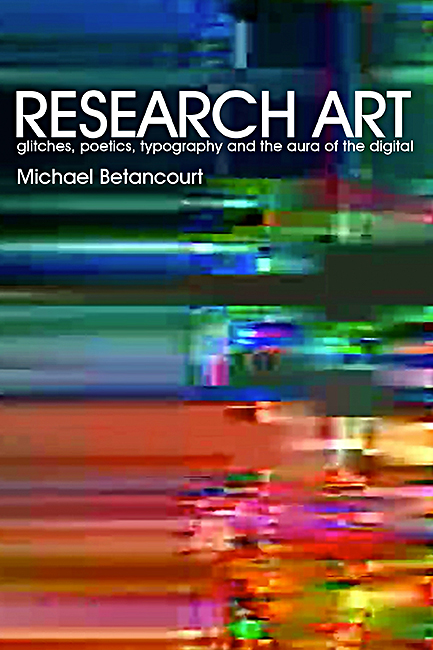
|
| |

|
| |
 |
Research Art - now available
story © Michael Betancourt | published September 17, 2021 | permalink |



 |
| 
|
 |


|
 |

My new book Research Art: glitches, poetics, typography and the aura of the digital is now available from amazon.com! Full color illos, and only $24.95!
This book discusses linking theory and practice in a larger context of conceptual and theoretical concerns that are neither a statement of intentions, nor merely a subjective series of claims about past accomplishments. With 21 illustrations in full color, this book discusses his digital glitch movies, typoetry, abstract photography, and the Instaglitch series as direct examples of the connections between theory and practice, illuminating his proposal for "Research Art" as a domain equal to the "Business Art" familiar from exhibitions in the gallery-fair-museum network. Polemical and often challenging, it explores the role of expectations in making and interpreting art from the vantage point of the studio, rather than as a critic or historian, arguing that "Research Art" is the evolution of the critical position developed by Conceptual Art and Situationalism as the avant-garde program in art came to an end, an adaptation to the changed Contemporary reality of AI, globalization, and digital technology, an oppositional art made in the shadows of digital capitalism.
|

|
|
|

|
| |
 |
new Listserv for Video Art!
story © Michael Betancourt | published August 18, 2021 | permalink |



 |
| 
|
 |


|
 |
|
Subscribe Here
Listserv-VideoArt is an international forum for media art in all its forms: digital video, experimental video, avant-garde video, video art, video installation, light art, glitch art, visual music and visual poetry; video's expressive qualities, aside from or in addition to its storytelling capacity. Any genre of both digital and analogue video art, including diary, glitch, abstract, processed, animated, found footage, lyric, subversive, expanded, projection mapped, etc., can be discussed, as well as those movies which fall into the cracks between the genres, or those not covered by other lists.
All aspects of video art, from production to criticism, are acceptable in this context, including personal productions, techniques, histories and aesthetics of video art, critical discussions, new directions, courses and teaching, festivals, announcements of world-wide events in video art, exhibitions and retrospectives, exchanges of information, etc. This list is not intended for the discussion of commercial video or motion graphics, neither narrative film, nor documentary film, nor film as art, nor the history of avant-garde film.
|

|
|
|

|
| |
 |
The Aesthetic Problem Posed by Digital Capitalism
story © Michael Betancourt | published July 24, 2021 | permalink |



 |
| 
|
 |


|
 |
|
Here is a preview from my new book, Research Art: glitches, poetics, typography and the aura of the digital available soon:
Composer John Cage noted the �problem of history� in the 1950s; it is an issue that has grown more important, rather than less, in the decades since. Artists adopting a self-conscious positioning in relation to a specific history (tradition)�whether in a sense of continuing it, or in the sense of escaping from it�unifies the positivistic dimensions of Modernism and Post-Modernist alike. To the extent that the Contemporary embrace of relativism is �ahistorical,� it is not an escape from this avant-guardiste positivism, but a response to the post-structural critique that introduced a plurality of directions that now dominate discourse within the gallery-fair-museum network. This expansion of aesthetic opportunity has not minimized the need for self-conscious positioning, it has starkly highlighted it. The issue in confronting the Contemporary is to separate emotional, dialectical, traditional conceptions of �opposition� and �resistance� (the heritage of the avant-garde) to consider a tactical relaction that demonstrates Cage�s koan-like observation:
One does not then just any experiment, but does what must be done; one does not seek by his actions to arrive at money, but does what must be done; one does not seek by his actions to arrive at fame (success), but one does what must be done; but does what must be done; one does not seek by his actions to provide pleasure to the senses (beauty), but one does what must be done; one doe not seek by his actions to arrive at the establishment of a school (truth), but one does what must be done. One does something else. What else?
Cage, J. Silence (Middleton: Wesleyan University Press, 2011) p. 68.
|

|
|
read more (3584 words)
|

|
| |
|